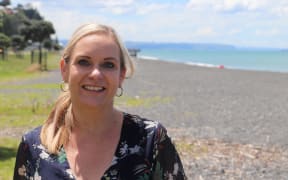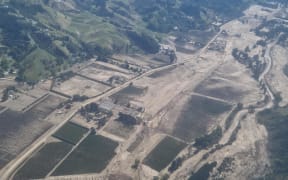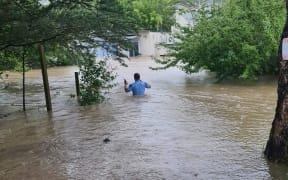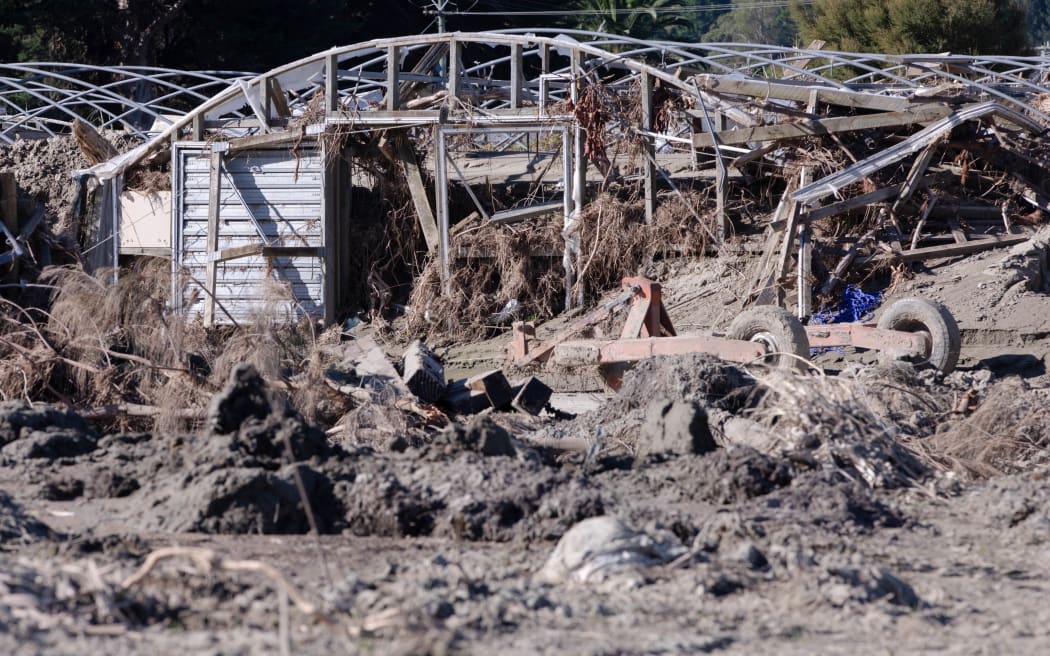
A shed in Esk Valley is filled with silt and debris from Cyclone Gabrielle in early March. Photo: RNZ / Angus Dreaver
Thousands of Hawke's Bay people with cyclone-damaged homes can start sitting down with council officials from Wednesday to nut out what exactly is going to happen to their properties.
There are 236 properties in the high-risk category three which qualify for a voluntary buyout - and there are more than 2500 in category two that can be lived in as long as they have better flood protection.
At a community meeting in rural Puketapu on Tuesday night, residents were starting to see the way ahead.
About 100 people took a seat in a school hall for a Q-and-A with Hawke's Bay Regional Council and Hastings District Council bosses.
The pair were quick to reassure the crowd that the maps putting land into categories one to three - from low to high risk - were far from final.
The regional council's interim chief executive, Bill Bayfield, said the Beehive had forced their hand to release them earlier than they were comfortable with.
"We announced those maps when minister [Grant] Robertson wanted us to, on the 31st of May," Bayfield said.
"In one of my new departments, a woman stood up and just let rip with an absolutely unbelievable scream, that she'd been classed as category three in Esk Valley."
But Bayfield said the woman's home was not high risk - and other people may find out the same applied to their homes.
He said the data the categories were based on did not drill down to individual properties and he would have liked to have waited for the final quality assurance - due on 14 June - before releasing the information.
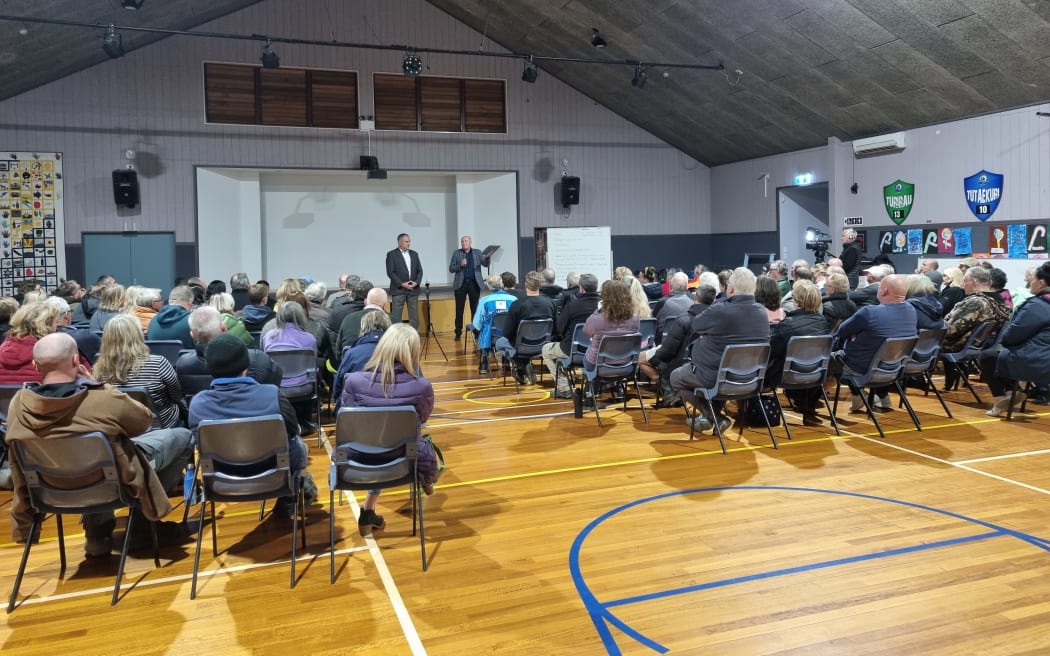
A community meeting with residents about cyclone and flood-damaged properties placed into risk categories in rural Puketapu on 14 June, 2023. Photo: RNZ / Lauren Crimp
Hastings District Council chief executive Nigel Bickle reiterated that the current maps were not set in stone.
"These are not decisions, they're provisional, they need to be assured," Bickle said.
"And then we actually have to come and have these conversations with the communities, and individuals within the communities, and that's the things that will happen over the next few weeks."
That consultation - a mix of community meetings, drop-in centres, and the opportunity for one-on-one conversations - would play a huge part in finalising a property's risk rating, Bickle said.
Bayfield told those with properties in category two - who might need to raise their houses or have bigger stopbanks and better drains - that they would not have to wait months for work to be finished before they could properly fix their homes and claim insurance.
They would be moved to category one before the work even started.
"You won't have to wait til the work is actually physically done," Bayfield said.
"Once that mitigation is agreed by the community that's going to be impacted and will contribute to paying towards it, and we've got the funding, then we will basically commence construction.
"But even before then, we will signal that two is down to one."
That was a relief for resident Bayne Smart.
"We're zone 2C, and we thought, that's it, we won't get any flood insurance," Smart said.
"But it looks like there's a good possibility that that'll go now into one," he said.
"Although insurances have gone up, but we'll get flood cover, that'll be a good thing."
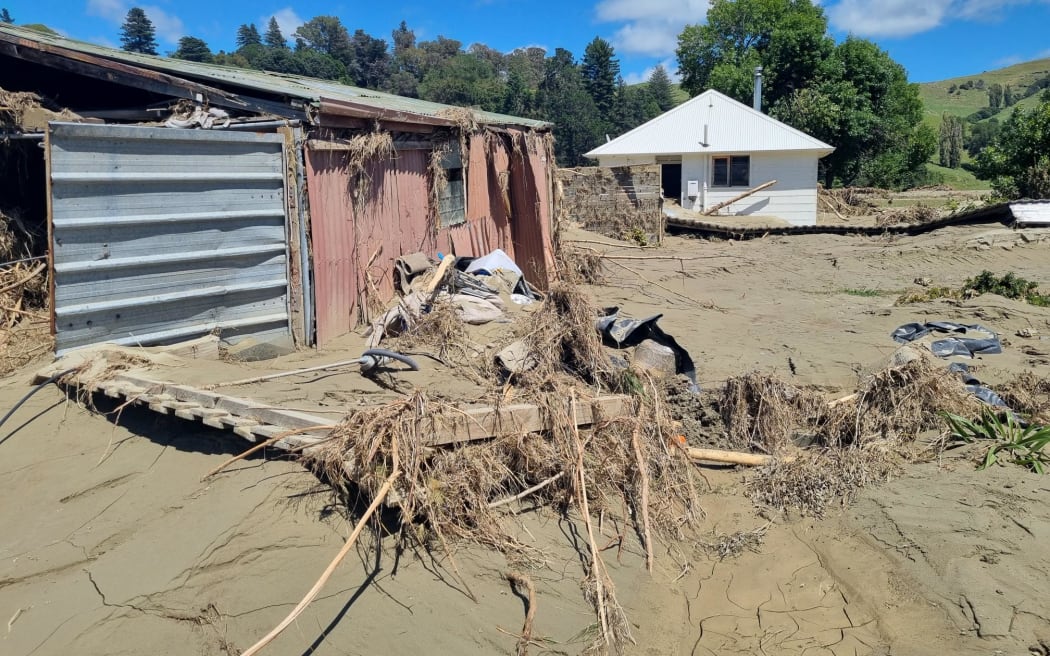
Flood damage seen in Esk Valley, Hawke's Bay in February, 2023. Photo: RNZ / Tess Brunton
Voluntary buyout deal struck by end of June
Bickle said councils had already begun negotiations with the government over splitting the cost of buying out high-risk homes which were too unsafe to live in.
Cyclone Recovery Minister Grant Robertson had promised a deal would be sorted out by the end of June, he said.
On the whole, the crowd were pleased with what they heard.
Dartmoor Valley fruit grower Lesley Wilson said while everyone wanted to move on with their lives, a lot had been done in the four months since the cyclone.
"When you're living it day to day, it does feel like it's very slow in progress," Wilson said.
"But we've got a little bit of information, which in most cases is better than none."
School principal Chris Fox said people left the meeting feeling "reasonably happy".
"But there's lots of unanswered questions, too - lots of promises that we'll only know if they materialise whether that's a fact or not."
Gisborne District Council and Auckland Council are following suit and asking affected property owners for input about the risk categorisation of their property.
More than 1000 Tai Rāwhiti properties have been affected by recent bad weather; most have provisionally been placed in category two and 17 are in the high-risk category three.
Gisborne District Council will run drop-in sessions and community hui to give people the chance to ask questions about their individual situations.
Mayor Rehette Stoltz said they would not have all the answers, but they wanted to hear from the community before categories were finalised.

